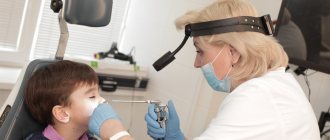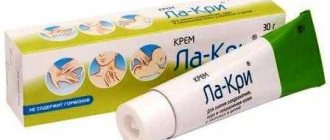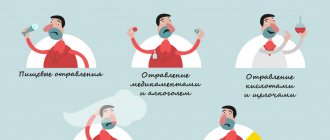Cooling the body
- disorder of body functions as a result of low temperature.
A distinction is made between general and local cooling (see Frostbite), however in practice general cooling is often combined with local cooling, and local exposure to cold can cause pronounced phenomena of general cooling.
P. M. Starkov (1957), E. V. Maistrakh et al. (1962) define general cooling as exposure to cold that is not accompanied by a decrease in body temperature below normal (for humans - not lower than 35 °). A drop in body temperature below this level (hypothermia), if caused by exposure to cold as a damaging environmental factor, indicates that the compensatory mechanisms of thermoregulation cannot cope with its destructive effect; in this case they talk about hypothermia of the body. Under freezing of the body G. A. Akimov et al. (1977) understand pathological hypothermia, accompanied by a dangerous disorder of body functions up to its death. The term “freezing” in relation to a whole organism is conditional, because, according to E.V. Maistrakh (1962), death occurs at a body temperature significantly exceeding 0°, when true freezing with the formation of ice is impossible. Thus, for a person, a decrease in temperature in the rectum to 17-18° is usually fatal, to 20° is almost irreversible, and to 25° is very dangerous.
In addition to cooling the body as a pathological factor, there is physiological cooling, observed in certain warm-blooded animals during hibernation (see) and artificial deliberate cooling in conditions of blockade of thermoregulation mechanisms and artificial maintenance of body functions, used in clinical practice (see Artificial hypothermia) .
Etiology
Cold, as a harmful environmental factor, has an adverse effect on the human body and production activities. The importance of this factor has especially increased in connection with the development of large territories of the Far North and Antarctica, navigation in high latitudes, flights in the stratosphere and outer space. However, hypothermia and freezing of a person are possible not only in extreme climatic conditions, but also in zones with a temperate and warm climate, including at above-zero temperatures.
The speed and depth of cooling, in addition to the strength and time of exposure to the cold factor, depend on the state of the body and the conditions in which it is located. The body's resistance to cooling decreases with physical fatigue, fasting, alcohol intoxication, blood loss, shock, injury and illness. Age also matters - in old people and children, resistance to cooling is reduced. A very significant factor contributing to cooling is alcohol intoxication, in which, due to the expansion of peripheral vessels, the perception of cold is weakened and even disappears, and heat loss increases. Hypothermia occurs more quickly with high air humidity, strong wind, especially if a person is wearing light, tight or wet clothing, when heat transfer sharply increases. A person cools down especially quickly when entering water; Freezing is possible even at relatively high temperatures. So, at a water temperature of 15°, a person can survive no more than 6 hours, at a water temperature of 1° - only 30 minutes. V. A. Bukov (1977) distinguishes acute, subacute and slow forms of O. in terms of the speed with which cooling in certain conditions can lead a person to death. In the acute form, death occurs within 1 hour of a person’s stay in water with a temperature of 0-10° or under the influence of moisture and cold wind when the body is exhausted. In the subacute form, death occurs within less than 4 hours. exposure to cold air in combination with moisture and factors that weaken the body. In the slow form, death occurs after 4 hours. exposure to the cold factor (cold air) while protecting the body with clothing or snow mass.
Massive injuries as a result of cooling have been observed during wars, catastrophes and natural disasters. So, for example, N. Korsun (1937) reports that during the Sarakamysh operation in 1914, the Turkish corps lost more than 10,000 people frozen in one night.
First aid
The victim must be moved from the cold to a warm, windless place, take off wet clothes, and wrap him in a blanket. You can warm a frostbitten area using heat-insulating materials, for example, cotton-gauze bandages with a layer of compress paper or plastic film; if this is not at hand, use foam rubber, blankets, and so on.
A hot drink and a warm bath will help you warm up. It is necessary to heat the water in it gradually. They start with a temperature of plus 17–18 degrees and within about an hour the water is heated to plus 36–37 degrees.
But you shouldn’t rub frostbitten skin with ice and snow. There is a high risk of further hypothermia and injury.
Pathogenesis
O. o. is a consequence of an imbalance in heat and develops in cases where heat transfer (see) in the body exceeds heat production (see). Cold is a strong irritant, so cooling of a warm-blooded organism is accompanied by pronounced functional, metabolic and biophysical changes. Many of them have been studied by Ch. arr. in an animal experiment. About the degree of O. o. usually judged by a decrease in rectal temperature, which reflects the state of thermal balance of the deep tissues of the body.
In the process of Cooling the body, there are phases of compensation and decompensation of thermoregulation. In the compensation phase, the body’s thermoregulatory reactions are reflexive, adaptive, protective in nature and are aimed at preventing a decrease in body temperature, on the one hand, by reducing heat transfer, and on the other, increasing heat production. A decrease in heat transfer is achieved by stopping sweating, spasm of the blood vessels of the skin and muscles, and a decrease in blood flow in them. Heat production is enhanced by increased metabolism. Important factors of thermogenesis are cold muscle shivering and increased muscle tone. In this phase, the number of heart contractions increases, blood pressure rises, the minute volume of the heart and respiration, the concentration of glucose and free fatty acids in the blood increase, and the glycogen content in liver cells and muscles decreases. Oxygen consumption increases 5-6 times. In an experiment on animals it was established that with O. o. in the compensation phase of thermoregulation, there is an increase in the electrical activity of the cerebral cortex, the secretion of thyroid-stimulating and adrenocorticotropic hormones by the pituitary gland, 17-hydroxycorticosteroids and adrenaline by the adrenal glands, an increase in blood viscosity, and an increase in the content of red blood cells and leukocytes. That. for the compensatory phase O. o. characterized by an increase in the functional activity of the main systems of the body.
In the decompensation phase of thermoregulation, the balance between heat production and heat transfer is disrupted, heat transfer predominates, and therefore a state of pathological hypothermia develops. At the same time, there is a clearly visible tendency to suppress the functions and activity of the body and reduce the metabolic rate. These changes develop against the background of discoordination of the functions of organs and systems. As hypothermia deepens, the functions of the cerebral cortex, and then the subcortical and bulbar centers, are inhibited. Rapidly occurring drowsiness deprives the freezing person of the opportunity to actively fight further cooling.
When body temperature drops to 33-30°, peripheral vessels dilate, heartbeats become less frequent, blood pressure decreases, minute blood volume decreases, and pressure in the portal vein system increases. Hyperventilation of the lungs is replaced by a progressive decrease in the minute volume of breathing, which becomes rare and superficial. At the same time, pO2 in tissues decreases, oxygen consumption by the body decreases by approximately 5% for each degree of decrease in body temperature; Cold shivering disappears, but EMG reveals increased activity of various muscle groups. The glycogen content in liver cells and muscle tissue sharply decreases. If the body is in a state of hypothermia for several hours, then hyperglycemia is replaced by hypoglycemia, diuresis is sharply inhibited, and glucose and protein appear in the urine.
With pathological hypothermia, hypoxia develops as a result of respiratory and circulatory disorders (inhibition of the respiratory and vascular centers, convulsions of the respiratory muscles, bradycardia). Tissue hypoxia (see) is also aggravated by impaired microcirculation due to decreased vascular tone, slowing blood flow and deterioration of the rheological properties of blood (thickening, increased viscosity, increased number of formed elements and hemoglobin concentration).
In addition, as body temperature decreases, the dissociation curve of oxyhemoglobin shifts to the left, so the removal of oxygen in tissues is difficult. All this contributes to the deepening of hypoxia, the accumulation of lactic acid and the occurrence of metabolic acidosis (see). At the same time, the tissue need for oxygen is significantly reduced due to a decrease in metabolic rate as hypothermia develops.
The degree of functional and metabolic disorders during hypothermia of a homeothermic organism is directly dependent on the strength of the cold factor and the duration of its influence. With rapid cooling, the body's energy reserves are less depleted, the duration of tissue oxygen starvation is shorter, but disorders of the cardiovascular system are more pronounced. Slow hypothermia may be accompanied by hypoglycemia, which is a sign of depletion of the body's carbohydrate resources.
Pathological anatomy
Morphological changes during cooling of the body are manifested by congestion of internal organs, the brain and spinal cord and their membranes, hemorrhages in the brain, interalveolar septa and gastric mucosa, small focal necrosis in internal organs, pulmonary edema, depletion of glycogen reserves in the cells of the liver and other organs.
The most common causes of death due to hypothermia are respiratory arrest, ventricular fibrillation, asystole, and collapse. Respiratory cessation occurs due to cold depression of the bulbar centers. It occurs with preserved cardiac activity, especially in those who are freezing when the head is predominantly cooled. The level of decrease in rectal temperature in humans has not been precisely established. In the experiment, breathing stops in cats and dogs at a rectal temperature of 24-19°. Ventricular fibrillation in humans can occur at temperatures from 28 to 24°, both during cooling and during warming. The cause of fibrillation is myocardial hypoxia, hypercatecholaminemia, sudden changes in blood pH and an increase in the Ca/K gradient in the myocardium. Asystole is observed relatively rarely in cases where neither respiratory arrest nor ventricular fibrillation of the heart occurred primarily. Collapse is a consequence of inhibition of the function of spinal vascular centers when cooling mainly the spinal area (staying in cold water, long periods of time in a supine position on ice).
Pathogenesis (what happens?) during General cooling:
Widespread changes such as chromatolysis, reactive lesions of nerve fibers and terminal structures are detected. Changes are observed in the cerebral cortex, cerebellum, subcortical nodes, and spinal cord. Noteworthy is the significant damage to the sensitive nodes: spinal, semilunar, and many vegetative nodes.
In people recovered from a state of deep cooling, reversible functional disorders are observed: changes in neuro-reflex activity, hyperthermia, vegetative-trophic disorders (foci of baldness, trophic ulcers), changes in the red and white blood system (anemia, leukocytosis, increased ESR), associated infectious diseases.
Clinical picture
According to V.A. Bukov (1977), in a wedge, the flow of O. o. There are four stages: compensatory, adynamic, soporous and comatose.
In the compensatory stage, victims are usually agitated and complain of chills. The lips are cyanotic, the skin is pale, cold to the touch, there is a symptom of “goose bumps”, muscle tremors, shortness of breath, tachycardia, increased blood pressure, and increased urination are noted. Temperature in the rectum is above 35°.
In the adynamic stage, consciousness is preserved, but the victim is inhibited, sometimes euphoric, and complains of headache, dizziness, and weakness. Adynamia, decreased muscle tone, and suppression of tendon reflexes are noted. Pupils of normal size. Breathing is not impaired. Depending on the degree of hypothermia, the pulse is of normal frequency or slowed down to 40 beats per minute, blood pressure is not significantly changed, and heart sounds are muffled. Some victims are able to eat on their own. The temperature in the rectum is 35-30°.
In the soporous stage, there is general lethargy, lethargy, drowsiness up to a state of stupor, sometimes euphoria, memory disorders, and dysarthria. With prolonged exposure to extreme cold, the reactions of thermoreceptors may be distorted and a false sensation of warmth may occur. The ability to move independently is lost, and the tone of the skeletal muscles often increases. The pupils are dilated or periodically narrow and dilate, breathing is slow (up to 8-10 per minute), superficial, sometimes with groans, pulse is rare (from 50 to 30 beats per minute), sometimes arrhythmic, blood pressure is reduced. Possible urinary and fecal incontinence. The temperature in the rectum is 29 - 25°.
In the comatose stage, consciousness is lost. Victims may have involuntary movements of the head and limbs, opening of the eyes, trismus, tension in the abdominal muscles, convulsive tonic contractions of the muscles of the limbs, mainly flexors. Sometimes motor excitement occurs. The pupils are constricted, their reaction to light is sluggish or absent, the corneal reflex is weak or lost, and there may be “swimming” of the eyeballs. Breathing is shallow, rare (up to 3-4 per minute), sometimes of the Cheyne-Stokes type (see Cheyne-Stokes breathing). The pulse is determined only in large arteries, it is rare (up to 20 beats per minute), blood pressure is reduced. Heart sounds are muffled and difficult to hear. The temperature in the rectum is below 25°.
Complications
at O. o. largely due to a sharp decrease in the immunological reactivity of the body. In this regard, the subsequent development of inflammatory diseases is possible - pneumonia, pleurisy, acute respiratory diseases, etc. In addition, the functions of other organs and systems may be disrupted, and therefore asthenia, psychoses, and trophic disorders often occur.
Diagnosis
Cooling of the body is established on the basis of anamnesis and examination data of the victim, among which the determination of rectal temperature is of primary importance. For this you need an electric or mercury thermometer with a graduation in the range of 15-45° (see Thermometry).
Treatment
Nature of medical care for O. o. depends on the depth of hypothermia and the nature of the body’s vital functions. In the compensatory stage of O. o. victims only need to stop the cold factor (shelter from the wind, additional clothing, etc.). In the adynamic stage, under appropriate conditions (being in a warm room, warm drinking, using heating pads, a warm bath), body temperature can also normalize on its own.
Victims in the soporous and comatose stages of O. o. need urgent help. The main efforts are concentrated on maintaining their breathing and blood circulation, preventing further cooling and warming the body. The victim is immediately transferred to a warm room, his wet clothes are removed, he is wrapped in blankets, and covered with heating pads. They eliminate the retraction of the tongue, suck out the mucus from the mouth, insert an air duct, perform oxygen inhalation, auxiliary or artificial ventilation of the lungs using the simplest methods (mouth to mouth, mouth to nose, through a breathing tube, mask) or using devices. In case of respiratory and cardiac arrest, the full range of resuscitation measures is carried out (see Resuscitation). The use of cardiac and respiratory analeptics is ineffective. If ventricular fibrillation occurs, electrodefibrillation at body temperature below 29°C is often also ineffective.
The main measure to bring a victim out of a critical condition is active warming. It needs to start as early as possible. Warming in a bath with water at temperatures up to 37° is most effective. In this case, warming the head should be avoided due to the risk of deepening brain hypoxia due to increased metabolism in conditions of limited oxygen delivery. You can also warm up by blowing warm air, covering with heating pads, using electric blankets, light lamps, washing the stomach with warm water, inhaling heated humidified air and oxygen. Active warming is stopped at a temperature in the rectum of 33-34° in order to avoid the subsequent development of hyperthermic syndrome (see). At soporous and comatose stages of O. o. It is advisable to carry out warming under conditions of superficial anesthesia, complete muscle relaxation and artificial ventilation. This allows you to eliminate certain protective reactions of the body to cold, in particular muscle rigidity and trembling, reduce the need for oxygen and reduce the phenomena of tissue hypoxia. During warming, a warmed 5% glucose solution, balanced electrolyte solutions, polyglucin or rheopolyglucin are poured in dropwise. To replenish energy material, 40-50 ml of 40% glucose solution with insulin and ascorbic acid are periodically administered. Blood is usually transfused if there has been blood loss. When warming, arterial hypotension may occur or worsen, due to the expansion of peripheral vessels and the entry into the bloodstream of patol, metabolites from tissues with long-term impaired blood circulation. In such cases, it is necessary to significantly increase the volume of infusions, focusing on the level of central venous pressure and ensuring hourly monitoring of diuresis. To improve cerebral circulation, you can use aminophylline, antipsychotics or ganglion blockers in doses that do not cause a decrease in blood pressure. To correct acidosis, infuse 100-200 ml of 5% sodium bicarbonate solution. Antihistamines are also used to reduce the permeability of vascular walls. The aggravation of patol and symptoms during warming is somewhat less pronounced if initially, along with external ones, internal methods of warming were used (through the stomach, rectum, lungs).
According to B. G. Volynsky et al. (1965), in the soporous and comatose stages of hypothermia, a paradoxical effect of drugs is possible, so they should be used strictly according to indications. For the prevention and treatment of post-hypoxic cerebral edema and stimulation of urination during and after warming, diuretics are used (furosemide - 40-60 mg, mannitol - 1 g/kg). Simultaneously with removing the victim from the state of hypothermia, possible complications are prevented or treatment of existing complications and concomitant diseases is carried out.
First aid for hypothermia
The victim needs to be helped to restore normal body temperature. The simplest and safest method is warm clothes, blankets and a warm room. It is very important to keep your head covered because it gives off 30 percent of the heat. Electrically heated blankets can be used. Only the chest needs to be warmed, otherwise complications may occur.
Hot drinks and a warm bath (heat gradually to a temperature no higher than plus 36 degrees) help. In the bath, you can gently rub your body with soft washcloths. With a mild degree of cooling, only warming is sufficient; with moderate and severe cooling, the victim needs medical attention.
Prevention of cooling
Prevention of cooling includes a complex of sanitary and hygiene. activities: supply of warm clothing and footwear, proper organization of work in the cold season, installation of heating points, provision of hot meals, control of participants in marches and winter sports competitions, prohibition of drinking alcohol before a long stay in the cold. In addition, hardening the body and acclimatizing a person to harsh environmental conditions are of great importance (see Acclimatization, Hardening).








